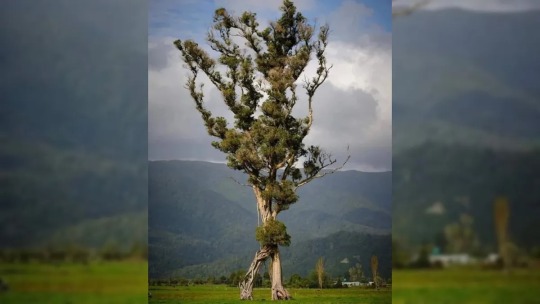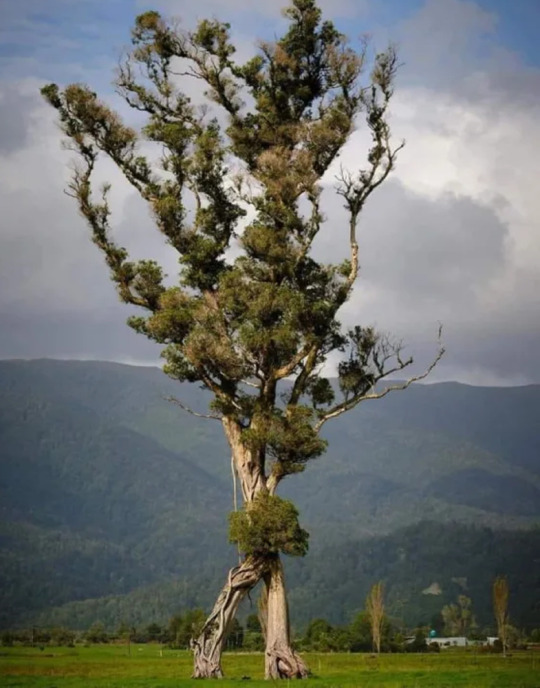#Northern Rātā Trees Are Epiphytes
Explore tagged Tumblr posts
Text
100-Foot 'Walking Tree' In New Zealand Looks Like An Ent from Lord Of The Rings — And Is The Lone Survivor Of A Lost Forest
An Unusual Northern Rātā Tree that looks like it is striding across an empty field has been Crowned New Zealand's Tree of the Year. The Giant Plant, which looks strikingly similar to an Ent from "The Lord of the Rings," is Centuries old.
— By Harry Baker | June 5, 2024

The "Walking Tree" is a Northern Rātā (Metrosideros Robusta). It is more than 100 Feet Tall and at least 150 Years Old. Image Credit: Gareth Andrews
A bizarre, giant tree with a pair of leg-like trunks looks like an Ent from "The Lord of the Rings" — and it has just been crowned New Zealand's Tree of the Year after strolling past the rest of the competition.
The strange tree, which has been nicknamed the "Walking Tree" because it looks like it's striding across a field, is a northern rātā (Metrosideros robusta) — one of New Zealand's tallest flowering tree species that can live for up to 1,000 years. It's roots and long, arm-like branches make the tree look like an Ent — a fictional race of tree-like creatures that guard the forests of Middle-earth.
The tree stands alone in the middle of a large paddock next to a cemetery near Karamea on the west coast of South Island. It is around 105 Feet (32 Meters) Tall — around the same height as a seven-story building, according to The New Zealand Tree Register.
The walking tree was the clear winner of the 2024 edition of the New Zealand Arboricultural Association's (NZ Arb) Tree of the Year award, walking away with 42% of the public vote, which included five other finalists, according to a statement emailed to Live Science.
"It just strode out into the lead right from the very start," competition organizer Brad Cadwallader told Radio New Zealand.
The walking tree is an "Exceptional Feature" and a "prime example of the remarkable trees that we, as New Zealanders, are fortunate to experience," NZ Arb President Richie Hill said in the statement.

A tall tree with a pair of thick leg-like roots that make it look like the tree is walking. Image Credit: Gareth Andrews
It is unclear exactly how old the walking tree is, but award organizers noted it is the lone survivor of a forest that was cleared around 150 years ago. "The farming family back then clearly thought it was special because they left it," Cadwallader said.
Northern Rātā Trees Are Epiphytes — a type of tree that starts life growing on the surface of a host tree before growing aerial roots that eventually reach the ground. The walking tree likely began life high up in the canopy of its host, living off air and rainwater before reaching the ground. Its unusual root layout was likely caused by how it grew around its host tree, which probably died off centuries ago.
"That host tree has now gone," Cadwallader said. "Maybe the tree was either very, very big, or there may have been another tree that fell and lent against the host tree, and that's why the roots have split near the ground and given it that walking appearance."

Northern Rātā Trees bloom bright red flowers between November and January. Image Credit: Shutterstock
Northern Rātā Trees are endemic to New Zealand and were once one of the most common species in the country's forests. However, their range has decreased over the last few decades and they are now listed as nationally vulnerable, according to the New Zealand Plant Conservation Network.
In addition to deforestation, the main threats to northern rātā are the invasive common brushtail possums (Trichosurus vulpecula), which destroy the trees by eating their leaves and gnawing at their roots.
The trees are also threatened by hybridization with the closely related Pōhutukawa Trees (Metrosideros Excelsa) and are susceptible to Myrtle Rust (Austropuccinia Psidii) — a Pathogenic Fungi native to South America that was detected in New Zealand for the first time in 2017.
#Planet Earth 🌍#Plants 🌱🪴#The Walking Tree#New Zealand 🇳🇿#The Lone Survivor | Lost Forest#An Ent#New Zealand Plant Conservation Network#Northern Rātā Trees Are Epiphytes#Brad Cadwallader#Exceptional Feature#NZ Arb | President | Richie Hill#Pōhutukawa Trees (Metrosideros Excelsa)#Myrtle Rust (Austropuccinia Psidii) | Pathogenic Fungi#Live Science
0 notes
Text
#2735 - Metrosideros umbellata - Southern Rātā

Endemic to New Zealand.
It grows up to 15m (49 ft) or more tall with a trunk up to 1 metre (3 ft 3 in) or more in diameter. Unlike its relative, northern rātā, it rarely grows as an epiphyte, but he flaky bark is an ideal growth surface for other epiphytes. Uncommom from the North Island, but increasingly abundant as you go south to Stewart's Island and the Auckland Islands.
The abundant flowers are an excellent source of nactar, but the tree is slow to establish. Resistant to salt and wild, so a good tree for coastal areas.
Orokonui Ecosanctuary, Aotearoa New Zealand
2 notes
·
View notes
Text
Week 12 - Atmosphere 2 – project ambience

Main insights
Indoor learning opportunities
Walkways
Touch with nature
Information signs
Children wandering in trees.
Research on plants.
Pōhutukawa is New Zealand's Christmas tree, and holds a prominent place in Maori mythology.

Mainland pōhutukawa (M. excelsa) occurs naturally in the upper half of the North Island (north of New Plymouth and Gisborne) although it grows from one end of the country to the other. It is easily distinguished from rātā by the hairs on the underside of the leaves.
Sacred trees- Pōhutukawa and rātā hold a prominent place in Maori mythology. Legends tell of the young Maori warrior, Tawhaki and his attempt to find help in heaven to avenge his father's death. He subsequently fell to earth and the crimson flowers are said to represent his blood.
Possibly the most famous pōhutukawa in Maori legend is a small, wind-beaten tree clinging to the cliff face near Cape Reinga. The 800-year-old tree is reputed to guard the entrance to a sacred cave through which disembodied spirits pass on their way to the next world.
Rātā was often respected for its immense size, which provided, among other things, shelter for weary travellers.
Under threat -Pōhutukawa and rātā are threatened by the following:
People damage trees by using their branches for firewood, lighting fires under them and parking cars on their roots.
Animals browse on young trees, and the forest understory that offers protection and nourishment.
Weeds and grasses often prevent regeneration by smothering young seedlings.
Since then, more than 300,000 native trees have been planted, with a focus on pōhutukawa and rātā. These well known New Zealand trees now have a better outlook but still need our help to protect them.

Rātā trees, along with the pōhutukawa, are one of the best known native trees in New Zealand.
Native birds benefit from rātā, but as possum numbers increase the threat to native birds and to rātā has also grown.
Did you know- The rātā and pōhutukawa belong in the myrtle family of trees. Other members include mānuka, kānuka and swamp maire.
Rātā trees have glossy dark green leaves and trunks that are often gnarled and twisted. However they are best known for their brilliant red flowers that appear in profusion from November to January, depending on location, and can be seen from some distance away.
The trees tend to flower well only once every few years and seem to favour the high rainfall conditions of the West Coast.
Native birds such as the tui, bellbird and kāk�� all benefit from the presence of rātā trees in the forest.
Southern rātā is the most widespread of all New Zealand rātā. It is found from sea level to 760 metres. It is distributed from high Northland and Coromandel outcrops, to subantarctic Auckland Islands where it forms the country's southernmost forests. The most dense display of southern rātā occurs along the South Island's West Coast
Rātā trees cannot tolerate browsing. A mature tree can be killed in three years with intensive browsing and even young trees, although they can survive for longer, will eventually die if browsed regularly.
When the browsed trees eventually die back, the canopy, or top layer of the forest, is then opened up. Once the canopy is open, the trees are exposed to storms, insects and diseases and will suffer further.
RātāNorthern rātā - Northern rātā (Metrosideros robusta) is one of New Zealand's tallest flowering trees. It usually begins life as an epiphyte (or plant perched on a host tree) high in the forest canopy. Its roots grow down to the ground, finally enclosing the host tree and producing a huge tree up to 25 metres high with a trunk of 2.5 metres through. It is found throughout the North Island and in the South Island, south to about Westport.
Southern rātā- Southern rātā (Metrosideros umbellātā) grows from a seed in the ground to become a tree up to 15 metres high with a trunk 1 metre through.Bartlett's rātā - Bartlett's rātā (M. bartletii) has white flowers and pale, papery bark, which make it unique among New Zealand rātā. This species was discovered in a forest remnant near Cape Reinga in 1975 and is listed as endangered. Very few adult trees remain.
0 notes